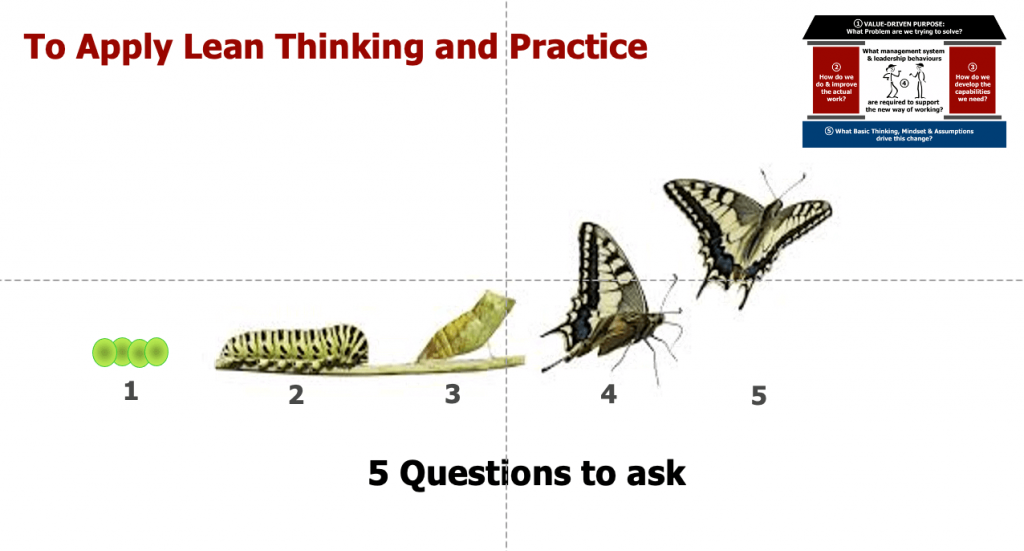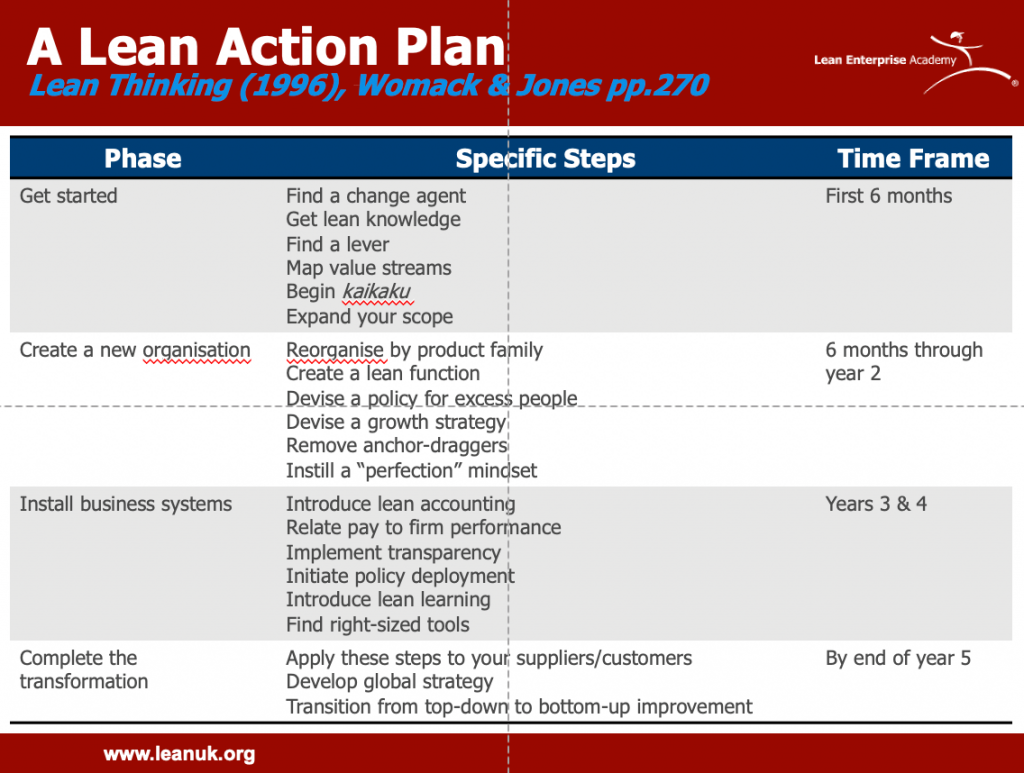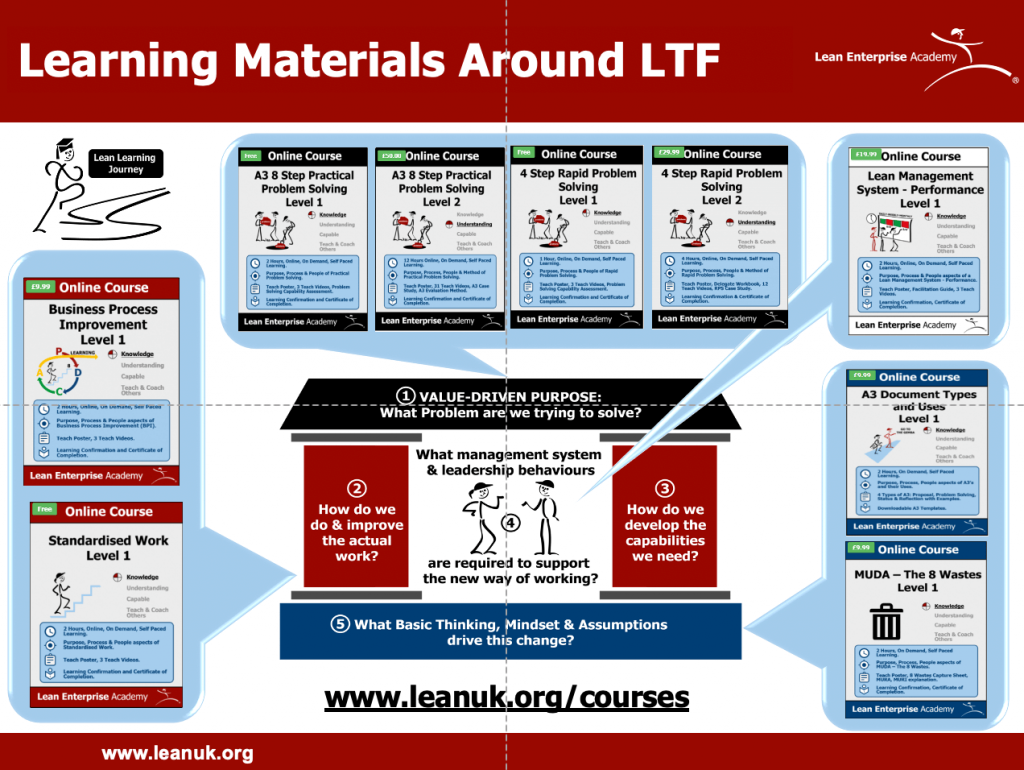In January 2014, John Shook shared the Lean Transformation Framework. This is the framework we have been developing to guide transformations with our partner companies, large and small, across a wide range of industries. We now have seven years of research around the lean transformation framework. Here are some key reflections.
What is Lean Transformation?

The term transformation suggests a marked change – that could be in terms of form, nature, character or appearance. In a business context transformation is about profound change that orientates the organisation in a new direction and takes it to an entirely different level of effectiveness. The conundrum of what to do to apply or embed lean thinking and practice in an organisation is well documented. In Lean Thinking (1996) Jim Womack and Dan Jones propose a “Lean Action Plan.” to start.

This is not a bad list – but we’ve learned so much more in the last 20 years. Firstly, we’ve learned that doing lean is situational – it starts by understanding the problem you are trying to solve. Dan Jones and Jim Womack highlighted the way to “think” about lean. That is by posing questions based on principles, rather than providing answers and deploying tools. The lean transformation framework applies the same process to introducing change using lean thinking and practice.
Transformation is important because it is relevant wherever you are on your lean journey.
- You are at the start and want to be aware of the key elements. Perhaps to understand the way to think about transforming into a lean organisation.
- You are trying to sustain and improve. Understanding the performance gaps that you have helps you develop the plans and actions to close them.
- Whether you are a senior leader, in an improvement team or leader of a front-line team and struggling for traction understanding these elements is equally important.
Applying problem solving to Lean Transformation
Excellent lean companies try to compress time. If you are making products or providing services then time to markets often critical to success. That is from concept to launch and time from order to delivery. To compress time each step of a value stream needs to produce and deliver right first time on time. In addition, through successive new launches and continuous improvement – in less time. The best lean companies employ lean principles, concepts and tools to highlight problems that prevent or hinder them from delivering right first time on time. They know whether they are behind or ahead and put countermeasures in place to get back on track.
So, here are a couple of challenging questions for you: “Can we apply time compression to lean transformation? Can we apply the processes we use to be able to deliver a product or service “right first time, on time, every time, in less time” to the Lean Transformation process? Perhaps you’ve never thought about transformation in this way – but I am sure that many of you have thought about the symptoms of not being able to do transformation better and faster (and cheaper.) The symptoms are expressed in terms of: “This guy just doesn’t get what we are trying to do.” “How do we speed up the change process?” “My boss just doesn’t get all this lean stuff.”
Applying Problem Solving to a Transformation
Applying problem solving to the transformation process can be an effective start. To do this we need to grasp the situation and understand where we are – and then understand where we want to get to – a target condition or conditions – for a set of factors that help us explain what we are trying to change. In other words we need to define the problems we are trying to solve. The gap or gaps between the way things are now and the way they are supposed to be or we want or expect them to be in the future. The gaps we are trying to close.
The Lean transformation Framework is an articulation of the key questions we need to address when thinking about the transformation we are trying to do. The framework contends that the successful implementation of lean thinking and practice requires change on 5 dimensions. We can assess the gap or gaps on each of these dimensions thus starting the problem solving process on the transformation. It is important that, while the questions are generic, lean thinking has a point of view on each of these 5 dimensions.
What Problem are we trying to solve?
Lean always starts with the customer. Asking what value we need to provide. The question “what problem are we trying to solve?” is fractal, like a snowflake. It applies equally to a whole organisation, a team or an individual. How are you doing organisationally and individually with this question? Does your organisation have a clear purpose? Do individuals have clear line of sight to it and understand their contribution to that Purpose and what problems they should be tackling?
How do we do & improve the actual work?
What is the work to be done to solve the problem? This is also fractal – from individual, standardised work level to value stream or enterprise value stream level. Is current state defined? What is your target (future) state? What steps and experiments do we need to close the gaps between current and the target or future condition?
How do we develop the capabilities we need?
Having defined the work to be done, we now ask what capabilities we need to do and improve the work to provide the value. Capability development is needed on (at least) two dimensions: Capability to do the work and capability to improve the work.
What management system & leadership behaviours are required to support the new way of working?
The design of the management system and leadership behaviours is key to designing the work and developing the capability. We have shared our views on Management Systems for Performance and Improvement in our last webinar. They are intrinsic to sustaining progress and further improvement. Are you asking specific questions with a view to this, linking back to the purpose of the organisation?
What Basic Thinking, Mindset & Assumptions drive this change?
The final question challenges our basic thinking or assumptions about how we do things and conduct ourselves. With Lean Thinking “it is easier to act your way into a new way off thinking, than think your way into a new way of acting.” Uncovering your basic thinking, mindset and assumptions helps articulate the thinking, mindset and assumptions needed. Ohno described TPS as a “revolution in consciousness” developed not by grand design, but by problem solving and designing experiments. TPS the Thinking Peoples System.
The framework borrows the house metaphor from Toyota. The house comprises foundations, two pillars and a roof. Of course many organisations are aware of Toyota’s Production System House – and many firms have tried to emulate or build their own versions – often by copying the elements. However the transformation framework is very different in it’s intent. Instead of listing the tools and techniques used or even the principles of jidoka and just in time we are seeking a way to communicate the questions one needs to think about when embarking on a Lean Transformation. What we’ve learned over the years is that each company’s circumstances are unique and therefore we need a situational approach to the transformation. However we must remember that it’s built around the lean approach.
Resources to help with your Lean transformation
To support your Lean Learning journey we have developed some FREE and paid courses for skill level 1 “Knowledge” and skill level 2 – “Understanding” around the LTF Framework for you to use. Here are some examples:

We also provide support online of face to face coached for Skill level 1- 4 on all these subjects and have launched a subscription service to our learning platform. You can gain accesses to all our online learning materials, webinars and supporting teach materials. The revenue raised goes into developing more learning processes to support you in applying Lean Thinking & Practice.
We are continually researching the application of lean thinking & practice in many different areas of the LTF to develop better, faster and cheaper learning processes.
Examples of our current research projects are:
- Problem Solving Capability Development of Leaders
- Management System – Performance
- Employee Involvement Teamworking
We are always collecting the questions you have on your lean journey, so do get in touch.